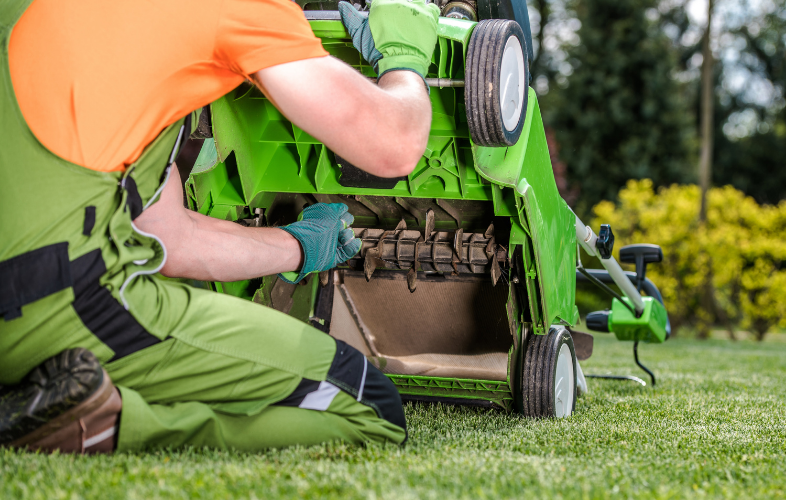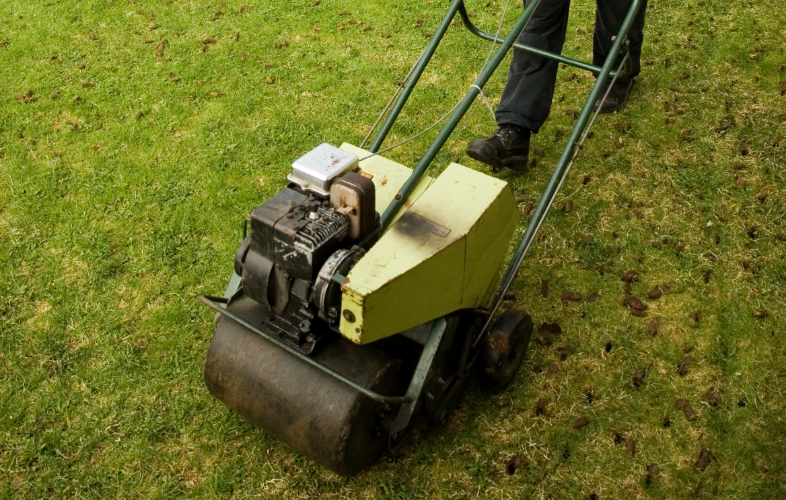Power Raking vs. Aeration
Reading time: 5 minutesWhenever you notice thatch on your lawn, you want to address it quickly. Most people choose aeration or power raking to handle the problem. However, your choice could harm your property more than help it.
We've compiled everything you need to understand these two services and learn the differences between aeration and power raking. We'll also cover why aeration tends to be the better option for your lawn and how it extends the life of your grass.
Understanding Power Raking and Aeration
Power raking and aeration can remove thatch, but your lawn will look different depending on your chosen service. Both of these processes utilize different equipment and have different goals, so it's essential to understand what you need before committing to one or the other.
What Is Aeration?
Aeration uses a core aerator to pull plugs of soil out of your lawn. The machine then drops them on the surface of your grass to recycle nutrients into the ground.
Aeration works to break up thatch and improve soil drainage and grass growth.
What Is Power Raking?
Power raking uses heavy tines on a lawnmower or tractor attachment to slice through the thatch on your lawn. The vigorous movement of the sharp metal tines can easily cut up thick layers of thatch.
Unfortunately, this method can rip up your grass and the top few inches of the soil. Unlike aeration, power raking does not help soil compaction or promote healthier grass growth as aeration does. Instead, the treatment is focused on the surface of the lawn.
Why People Use Aeration or Power Raking
Aeration and power raking both serve as possible solutions to excessive thatch growing over yards or soil compaction problems. The severity of these issues plays a role in the type of equipment homeowners choose to use.
The Pros and Cons of Thatch
Before knowing why power raking and aeration may work as solutions to thatch, you need to know what thatch is and when it's necessary to remove it.

Your lawn has several layers above the soil, but you may only think about the greenery at the top. However, just below the grass blades are the crowns of the grass. Below is a natural layer of organic, partially decomposed material called thatch. The soil sits below the thatch.
Thatch can help or hurt your lawn, depending on its thickness. Healthy properties often have a thatch layer measuring one-half-inch or thinner. This thin thatch layer insulates the soil from extreme heat and cold.
However, the thatch layer thickens if the grass produces more dead organic matter than the soil microbes can break down. This leads to thatch buildup and is one of the most common lawn problems homeowners face.
A thick layer of thatch blocks water, air, and nutrients from sinking into the soil and reaching the grassroots. However, it still allows insects and diseases to proliferate in the thick, organic material. Thick thatch continues to build and worsens issues of dying grass, insects, and diseases.
Dethatching
To remove thick thatch from lawns, homeowners may see recommendations, such as those from the City of Calgary, to use a power raking machine or dethatcher. These machines use tines to cut through the grass and thatch and lift them from the ground.
However, this method can cause injury to the lawn because the machinery can remove too much of the top layer of soil, damage healthy grass, or harm your irrigation system heads. Only when thatch exceeds two inches in thickness would power raking help.
Aeration also works to dethatch a lawn. This method removes core cylinders of soil, which include the thatch and grass at the top of the plugs. The thatch is broken up as the aerator removes these plugs from the ground. Clearing these little sections from the dirt also fixes soil compaction and reduces thatch buildup.
By improving soil density, aeration encourages healthier grass growth and a more vibrant microbial environment that can break down organic matter easily. It helps that aeration aids in slowing thatch long-term.
Controlling Soil Compaction
Compacted soil does not have the thriving microbial life necessary to prevent thatch. It also prevents water and air from reaching grass roots. To fix this problem, you need to remove some of the soil and let the dirt and roots spread out naturally.
Power raking may cut through the top of the earth, but it does not address compacted soil deeper down. For correcting compacted soil, aeration works better.
Aeration opens up compacted soil by removing cores from the dirt, letting the soil spread out more. Reducing soil compaction helps moisture and air to reach the roots.
By removing plugs, the grass also has room to grow deeper into the soil, which supports healthier blades above ground. Plus, healthier grass keeps weeds away because the grass grows so thickly that weeds have nowhere to intrude.
What's the Difference Between Power Raking and Aeration?
Power raking and aeration both use powerful equipment to address issues with your lawn caused by thick thatch layers. However, the equipment and operation of each make these two methods distinct.
Equipment Used for Power Raking
Power raking involves a powerful, engine-driven version of a manual rake to remove thatch off the lawn. These devices may be separate machines or involve a lawnmower or tractor attachment, with sturdy metal tines rotating several inches down. Some of these machines allow you to change the raking depth to address multiple thatch thicknesses.
These machines aren't easily accessible to most homeowners because of their size and cost. Generally speaking, folks will rent a machine or pay a professional company to dethatch their lawn if they need to turn to power raking.
Aeration Equipment Used
For aeration, lawn care experts use a core aerator. This piece of equipment cuts out plugs from the ground and leaves them on the surface. Like power raking machines, core aerators are heavy, expensive, professional-grade pieces of equipment. Therefore, most homeowners who want to use one must find a rental or hire someone to aerate their lawns.
Power Raking Process
Power raking machines spin metal tines over the surface of your lawn. These tines rip through grass, thatch, and soil to cut and lift away thatch. Once cut off, the thatch needs proper disposal, preferably where you responsibly dispose of other yard waste.

Core Aeration Process
Core aeration cuts into the ground through grass, thatch, and soil. However, the plugs the aerator removes remain on top of your lawn. These pieces of dirt contain valuable nutrients that are recycled into the soil slowly as the plugs wear down.
The next time you mow your lawn, you will run over these plugs, further breaking them down, which promotes healthier soil and grass. Plus, there is low waste once your property has been aerated, so you don't have to consider disposal.
Aeration vs Power Raking: Lawn Impact
Your lawn's overall health and appearance will be impacted whenever you commit to services on your property. Both aeration and power raking can have lasting effects, so it's essential you understand what could happen.
How Aeration Affects Your Lawn
When you aerate your lawn, you reduce soil compaction, break up thatch, and encourage healthier growth. The soil also has a better texture, allowing roots to absorb moisture and nutrients efficiently. You can promote deeper root growth and more robust grass that chokes out weeds with looser soil.
If you want to fill out bald patches on your lawn or to have thicker grass, overseed your lawn after aeration. The process for this service opens the ground so seeds can go into the ground and have a better chance of germinating, allowing for better growth of existing grass and new seeds.
The Green Drop team recommends aerating your lawn annually in the fall to ensure that your grass will have strong roots and healthy growth to get it through the changing seasons.

What Power Raking Does to Your Lawn
Power raking removes thatch from your lawn, but the action of a power raking machine does such an effective job at eliminating thatch that it also takes grass and soil as well. Because this process is so thorough, your lawn can be left damaged and in worse shape than before.
After power raking, your lawn may need extensive cleanup and repairs. This is because your grass is ripped through at high speeds, leaving it vulnerable. You'll want to dispose of any debris and ensure you're regularly watering to encourage regrowth. Slow-release fertilizer and reseeding will also probably be needed.
Aeration or Power Raking: Which Is the Better Choice?
Power raking can damage your lawn, but aeration can improve grass growth and offer a way to avoid thatch in the future. Aeration is the better option for dethatching and fixing compacted soil because it is less invasive and has better immediate and long-term benefits.
When you aerate, the soil can better move water, gases, and nutrients toward the roots of your grass. Healthy soil encourages healthy growth from all the plants in it.
Therefore, because aeration promotes a healthier, lusher lawn than power raking by addressing problems with soil texture, the Green Drop GreenKeepers prefer this method for dethatching a yard over power raking.
Why Choose a Professional to Aerate Your Lawn
Don't risk your lawn's health and appearance by trying to remove thatch on your own or struggling to find the right tools for aeration or power raking. Professionals provide the skills and experience to aerate your lawn and combat thatch properly.
Green Drop proudly offers aeration and overseeding with our other lawn care services with 100% satisfaction guarantees.
Check out our lawn care service packages to dethatch your grass and uncover a more beautiful lawn.

